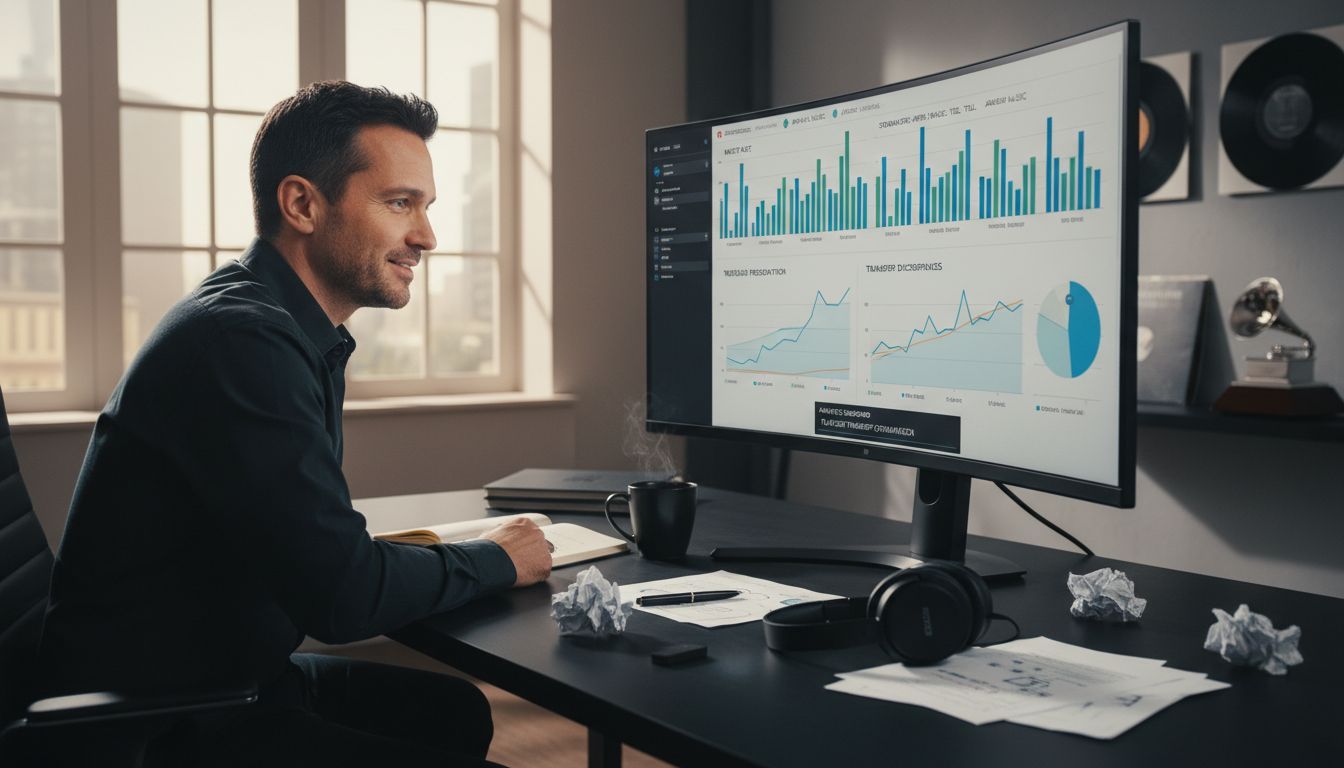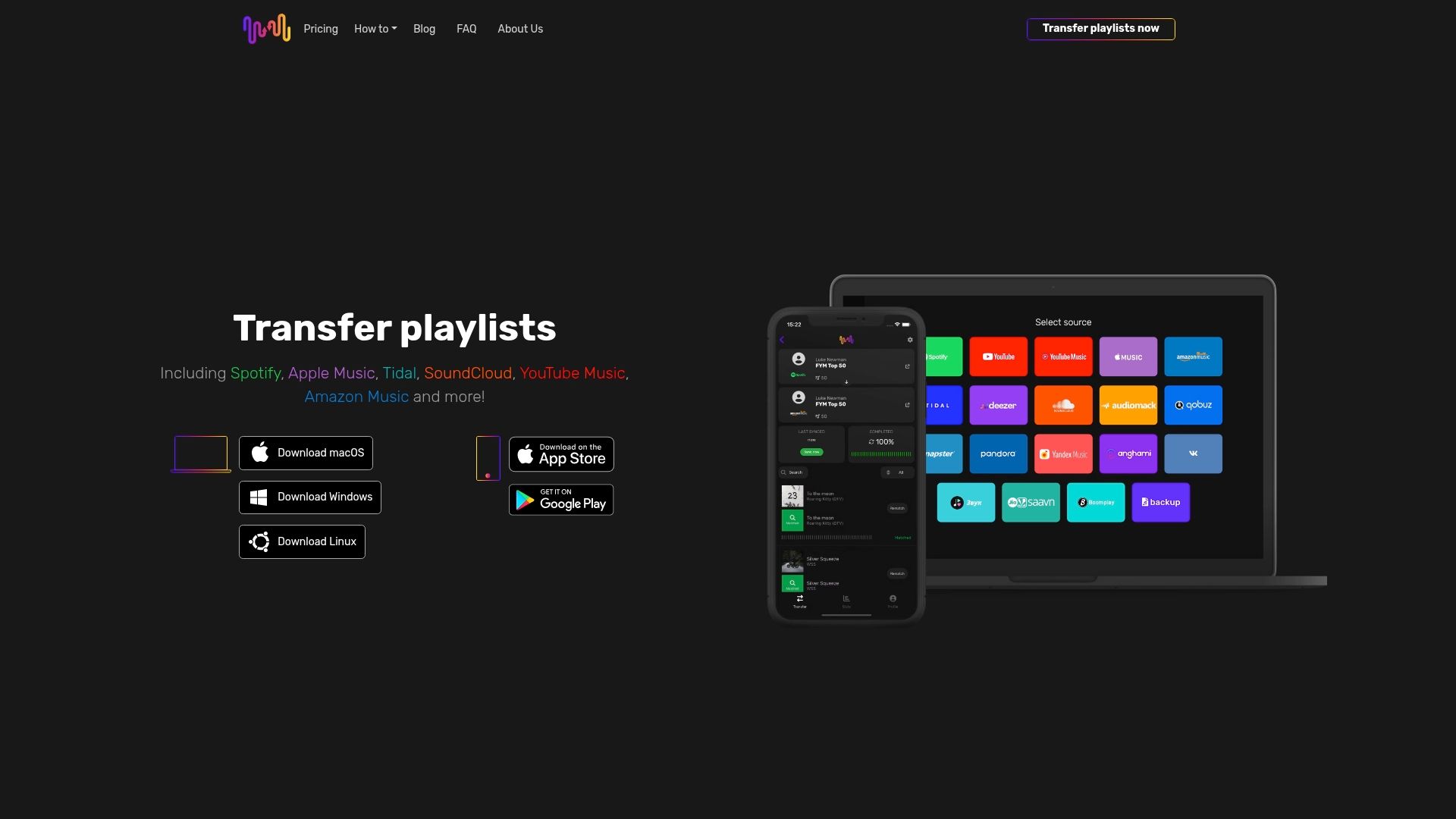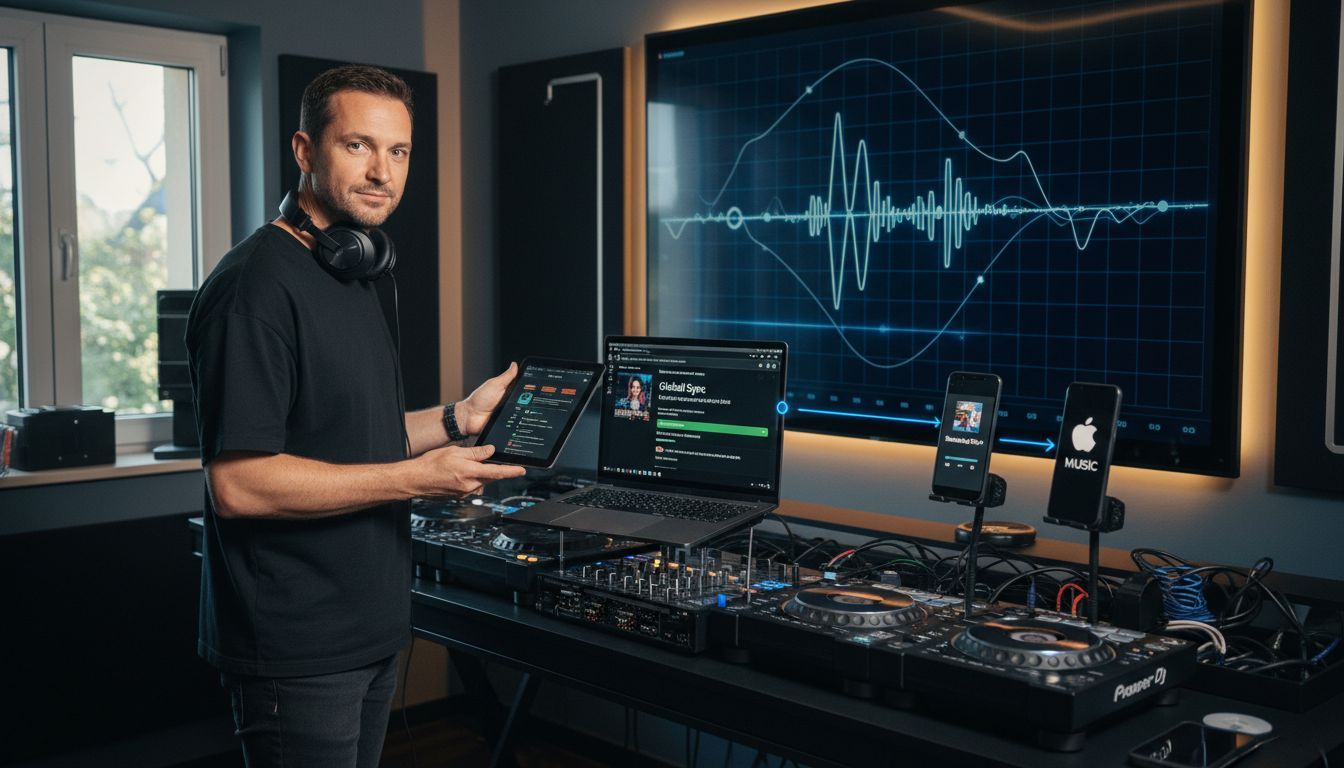Most music fans are surprised to learn that nearly 40 percent switch between streaming platforms each year, risking the loss of their favorite playlists. Protecting hard-earned music collections is a real concern, yet many misunderstand how playlist syncing works or believe it offers flawless track transfers. This guide clears up common myths and helps you understand the real advantages and limitations of syncing playlists so you can keep your musical journey on track.
Table of Contents
- Playlist Syncing Defined And Common Misconceptions
- Types Of Playlist Syncing Across Platforms
- How Playlist Syncing Works Technically
- Key Benefits And Real-World Use Cases
- Potential Risks And Data Privacy Concerns
- Playlist Syncing Vs. Playlist Transfer Differences
Key Takeaways
| Point | Details |
|---|---|
| Understanding Playlist Syncing | Playlist syncing allows users to transfer music collections across platforms while preserving playlist structure and metadata, but it is not a simple copy-paste operation. |
| Types of Syncing Methods | Various methods exist for playlist syncing, including automated matching and cloud-based transfers, each catering to different user needs and complexity levels. |
| Technical Considerations | Successful syncing relies on sophisticated algorithms and metadata analysis, yet users should be cautious about potential discrepancies and data privacy risks. |
| Syncing vs. Transferring | Playlist syncing offers continuous updates between platforms, whereas playlist transfer represents a one-time migration; understanding these differences helps users choose the right approach. |
Playlist Syncing Defined and Common Misconceptions
Playlist syncing represents a sophisticated digital music management strategy that enables users to seamlessly transfer, replicate, and maintain music collections across multiple streaming platforms. According to insights from music24, playlists have evolved from simple song collections into complex data ecosystems with nuanced relationships between creators and listeners.
At its core, playlist syncing allows music enthusiasts to preserve their carefully curated song selections when switching between streaming services. This process goes beyond basic file transfer, involving intelligent matching algorithms that attempt to recreate playlist structures with maximum accuracy. Common misconceptions include believing that syncing is a one-to-one exact replication process – in reality, variations in music libraries across platforms can result in slight modifications during transfer.
Key Characteristics of Playlist Syncing
- Automated Matching: Songs are intelligently matched across different platforms
- Preservation of Playlist Order: Original playlist sequence is maintained
- Cross-Platform Compatibility: Works between multiple streaming services
- Metadata Retention: Attempts to keep playlist metadata intact
Users often mistakenly believe playlist syncing is a simple copy-paste operation. However, Free Your Music - Understanding Playlist Transfer Challenges highlights the complex technical challenges involved in accurately transferring music collections. These challenges stem from differences in music licensing, library availability, and platform-specific metadata requirements.
Navigating playlist syncing requires understanding its limitations and setting realistic expectations. While modern tools have significantly improved transfer accuracy, minor discrepancies are still possible due to the dynamic nature of music streaming ecosystems. Smart users approach playlist migration with flexibility, recognizing that some manual adjustment might be necessary to achieve a perfect musical transition.
Types of Playlist Syncing Across Platforms
Playlist syncing represents a multifaceted technological approach with several distinct methodologies for transferring music collections between streaming platforms. Users can choose from different synchronization strategies based on their specific needs, technical complexity, and desired outcomes. Free Your Music - Best Music Playlist Syncing Platforms highlights the nuanced landscape of transfer techniques available in 2025.
Primary Playlist Syncing Methods
- Manual Sync: Requires individual song-by-song recreation
- Automated Matching: Uses intelligent algorithms for bulk transfers
- Cloud-Based Sync: Leverages cloud infrastructure for seamless transfers
- One-Way Transfer: Moves playlists from source to destination platform
- Two-Way Synchronization: Maintains real-time playlist consistency
The most sophisticated playlist synchronization methods employ advanced machine learning algorithms to analyze song metadata, ensuring maximum compatibility across different streaming ecosystems. These techniques go beyond simple track matching, considering factors like song duration, artist variations, and regional music library differences.
Technical Synchronization Approaches
- Metadata-Driven Sync: Matches tracks using comprehensive song information
- Acoustic Fingerprint Matching: Uses audio characteristics for precise identification
- User Preference Analysis: Considers listening history for intelligent transfers
Professional music enthusiasts and DJs require more robust synchronization strategies that preserve playlist integrity. Free Your Music - Understanding Playlist Conversion emphasizes the importance of selecting the right sync method to maintain playlist structure, song order, and original curation intent.
Understanding these synchronization types empowers users to make informed decisions about their music migration strategies.
 While no single method guarantees 100% perfect transfers, combining multiple approaches and maintaining realistic expectations ensures the smoothest possible playlist transition across diverse streaming platforms.
While no single method guarantees 100% perfect transfers, combining multiple approaches and maintaining realistic expectations ensures the smoothest possible playlist transition across diverse streaming platforms.
How Playlist Syncing Works Technically
Playlist syncing is a complex technological process that involves sophisticated algorithms, metadata analysis, and intelligent matching techniques to transfer music collections across different streaming platforms. Free Your Music - What Is Seamless Playlist Transfer? reveals the intricate mechanics behind successful music library migrations.
Core Technical Components
- API Integration: Connects different streaming platform databases
- Metadata Parsing: Extracts detailed song information
- Acoustic Fingerprinting: Uses audio characteristics for precise track identification
- Machine Learning Algorithms: Improves matching accuracy over time
- Error Correction Mechanisms: Handles discrepancies during transfer
The technical workflow of playlist syncing begins with comprehensive metadata extraction. Each track's digital signature is analyzed, including attributes like artist name, track duration, album information, and unique identifiers. This granular approach allows sophisticated matching algorithms to find equivalent tracks across different streaming platform libraries.
Synchronization Process Stages
- Source Playlist Analysis: Comprehensive examination of original playlist structure
- Metadata Comparison: Cross-referencing track details across platforms
- Intelligent Matching: Identifying most compatible alternative tracks
- Playlist Reconstruction: Rebuilding playlist with matched tracks
- Verification: Confirming transfer accuracy
Machine learning technologies play a crucial role in enhancing sync accuracy. These advanced algorithms continuously learn from user interactions, improving track matching capabilities by analyzing historical transfer patterns and user preferences. Free Your Music - Understanding Playlist Transfer Best Practices emphasizes how these intelligent systems adapt and refine their matching techniques.
Ultimately, successful playlist syncing represents a delicate balance between technological precision and adaptability. While no transfer method guarantees 100% perfect replication, modern synchronization technologies have dramatically improved the ability to preserve musical collections across increasingly diverse digital ecosystems.
Key Benefits and Real-World Use Cases
Playlist syncing transforms digital music management by offering unprecedented flexibility and convenience for music enthusiasts across diverse user segments. Free Your Music - What Is Seamless Playlist Transfer? highlights the transformative potential of this technology in modern music consumption landscapes.
Primary User Benefits
- Time Efficiency: Eliminates manual playlist recreation
- Platform Independence: Enables seamless music library migration
- Preservation of Musical Memories: Maintains curated playlist integrity
- Cost Savings: Reduces time and effort in music collection management
- Enhanced Music Discovery: Facilitates exploring new streaming platforms
Professional musicians, DJs, and music curators particularly benefit from playlist syncing technologies. These advanced tools allow them to maintain complex, carefully crafted music collections without spending countless hours manually transferring tracks across different streaming platforms. The ability to preserve playlist order, metadata, and musical context becomes crucial for professionals who rely on precise musical organization.
Real-World Use Case Scenarios
- Music Festival Organizers: Quickly transfer and share event playlists
- Personal Music Collectors: Migrate libraries between services
- Radio Stations: Synchronize playlist archives across digital platforms
- Music Teachers: Share educational and instructional playlists
- Fitness Instructors: Maintain consistent workout music across platforms
Individual users encounter numerous practical scenarios where playlist syncing becomes invaluable. Free Your Music - Understanding Playlist Transfer Best Practices emphasizes how these technologies solve real-world challenges of musical content management.
Beyond individual convenience, playlist syncing represents a broader technological solution addressing the fragmented nature of modern music streaming ecosystems. By enabling seamless transitions and preserving musical collections, these tools empower users to explore new platforms without fear of losing their carefully curated musical experiences. The technology continues to evolve, promising even more sophisticated synchronization capabilities in the coming years.
Potential Risks and Data Privacy Concerns
Playlist syncing technologies, while innovative, introduce complex data privacy and security challenges that users must carefully consider. Free Your Music - What Is Playlist Sharing? highlights the nuanced landscape of potential risks associated with cross-platform music management.
Primary Privacy and Security Risks
- Data Exposure: Potential unauthorized access to personal listening history
- Metadata Leakage: Unintended sharing of personal musical preferences
- Platform Vulnerability: Security gaps during inter-platform transfers
- Consent Management: Complex permissions across multiple services
- Tracking Potential: Risk of comprehensive music consumption profiling
Inconsistent synchronization behaviors pose significant technical challenges. Spotify Community documents specific instances where playlist transfers between different devices and operating systems can result in unexpected data discrepancies, potentially compromising user experience and data integrity.
Critical Security Considerations
- Encryption Protocols: Verify end-to-end data protection
- Third-Party Access: Understand permissions granted during sync
- Data Retention Policies: Review how transferred data is stored
- User Consent Mechanisms: Confirm transparent opt-in processes
- Cross-Platform Tracking Prevention: Limit potential metadata exploitation
Music enthusiasts must remain vigilant about the digital footprint created through playlist synchronization. Free Your Music - Understanding Playlist Transfer Best Practices recommends implementing robust personal data protection strategies when utilizing cross-platform music management tools.
Ultimately, while playlist syncing offers tremendous convenience, users should approach these technologies with informed caution. Understanding potential privacy risks, carefully reviewing service terms, and maintaining proactive personal data management become essential in navigating the complex ecosystem of modern music streaming platforms.
Playlist Syncing vs. Playlist Transfer Differences
While often used interchangeably, playlist syncing and playlist transfer represent distinct technological approaches to managing digital music collections. Free Your Music - Benefits of Playlist Migration provides critical insights into the nuanced differences between these two methodologies.
Key Distinguishing Characteristics
-
Playlist Syncing:
- Real-time continuous updates
- Maintains ongoing connection between platforms
- Allows bidirectional changes
- Dynamic and continuously adaptive
-
Playlist Transfer:
- One-time static migration
- Moves playlist from source to destination
- No ongoing synchronization
- Represents a fixed moment of data movement
Synchronization represents a more complex, intelligent process compared to traditional playlist transfer. Unlike simple one-way transfers, syncing involves continuous communication between platforms, enabling real-time updates and maintaining playlist consistency across multiple streaming services. The technology adapts to changes, ensuring that musical collections remain current and accurately represented.
Practical Implementation Differences
-
Connection Methodology
- Sync: Establishes persistent platform connections
- Transfer: Creates a singular point-of-migration snapshot
-
Data Consistency
- Sync: Ensures ongoing playlist alignment
- Transfer: Provides initial library migration
-
User Interaction
- Sync: Requires ongoing user engagement
- Transfer: Minimal post-migration interaction
Free Your Music - Understanding What is Playlist Export emphasizes that while both methods serve music management needs, they cater to different user scenarios and technical requirements.
Ultimately, choosing between playlist syncing and playlist transfer depends on individual user preferences, technical needs, and the desired level of ongoing music library management. Understanding these nuanced differences empowers music enthusiasts to select the most appropriate approach for their specific digital music ecosystem.

Take Control of Your Music with Effortless Playlist Syncing
Struggling with the complexities of playlist syncing described in the 2025 guide? You know how frustrating it can be to worry about data mismatches, loss of playlist order, or starting your favorite music collections from scratch when switching streaming platforms. If you want to preserve your musical memories and save time while avoiding manual recreation, there is a reliable solution built just for you.

Discover how FreeYourMusic.com simplifies the syncing process by offering automated, precise playlist synchronization that respects your original playlist order and metadata. Whether you need to move playlists between Spotify, Apple Music, or YouTube Music, our platform supports seamless transfers with multi-account flexibility and cloud backup to keep your music safe. Stop letting technical challenges hold you back. Get started now and enjoy uninterrupted access to your favorite music across all services without compromise. Visit Free Your Music to experience smart playlist management and make the move with confidence.
Frequently Asked Questions
What is playlist syncing, and how does it work?
Playlist syncing is a digital music management strategy that enables users to transfer and replicate music collections across different streaming platforms. It involves intelligent algorithms that match songs, preserve playlist order, and maintain metadata during the transfer process.
What are the benefits of using playlist syncing?
Playlist syncing offers several benefits, including time efficiency by eliminating manual playlist recreation, platform independence allowing seamless migration between services, preservation of musical memories, and cost savings in managing music libraries.
What are the common misconceptions about playlist syncing?
A common misconception is that playlist syncing is a simple copy-paste operation. In reality, it involves complex technical challenges due to differences in music libraries, licensing, and metadata across different platforms, which can result in minor discrepancies during transfers.
How does playlist syncing differ from playlist transfer?
Playlist syncing allows for real-time updates and maintains ongoing connections between platforms, making it adaptive. In contrast, playlist transfer is a one-time, static migration that moves a playlist from one platform to another without ongoing synchronization.




